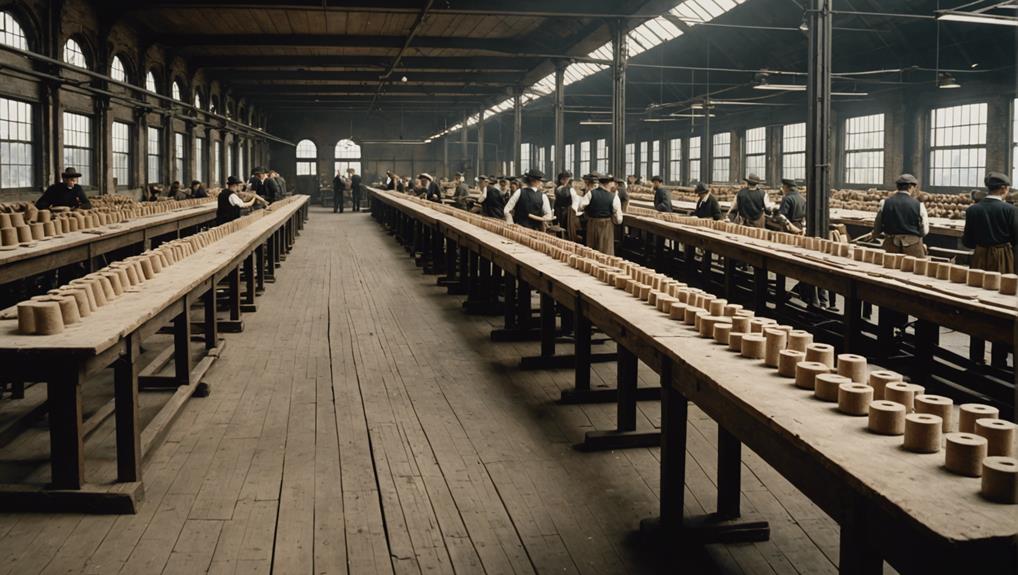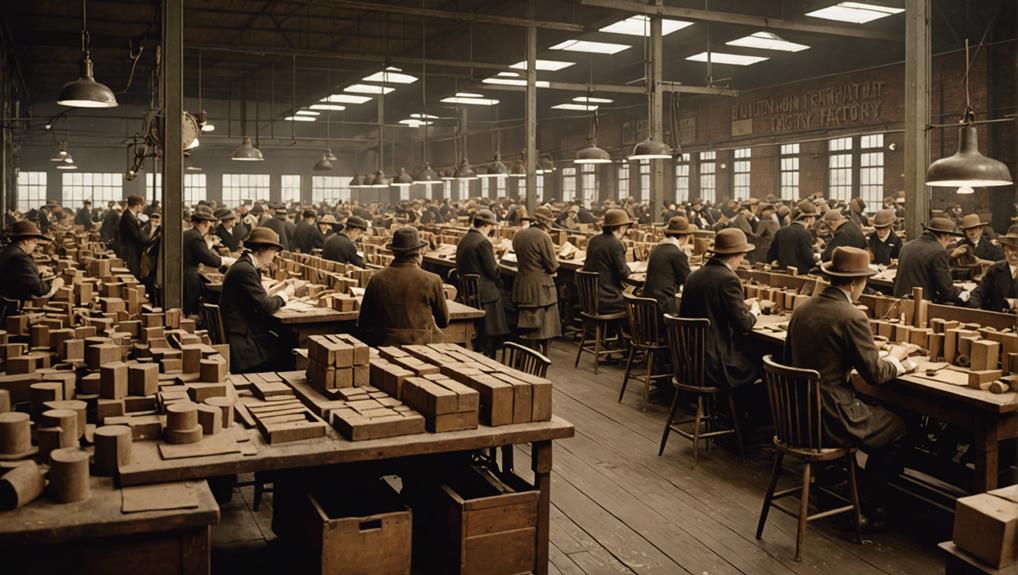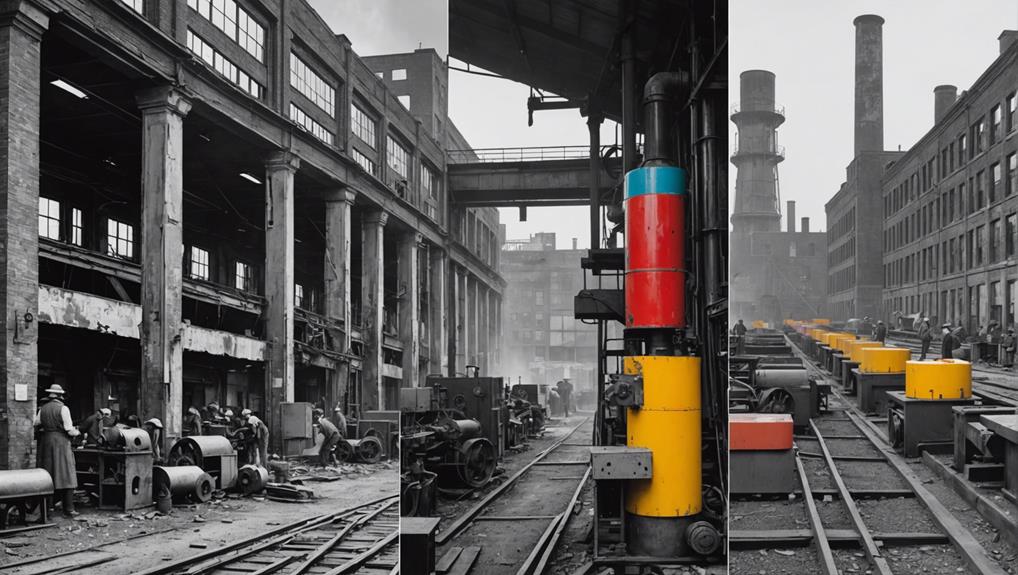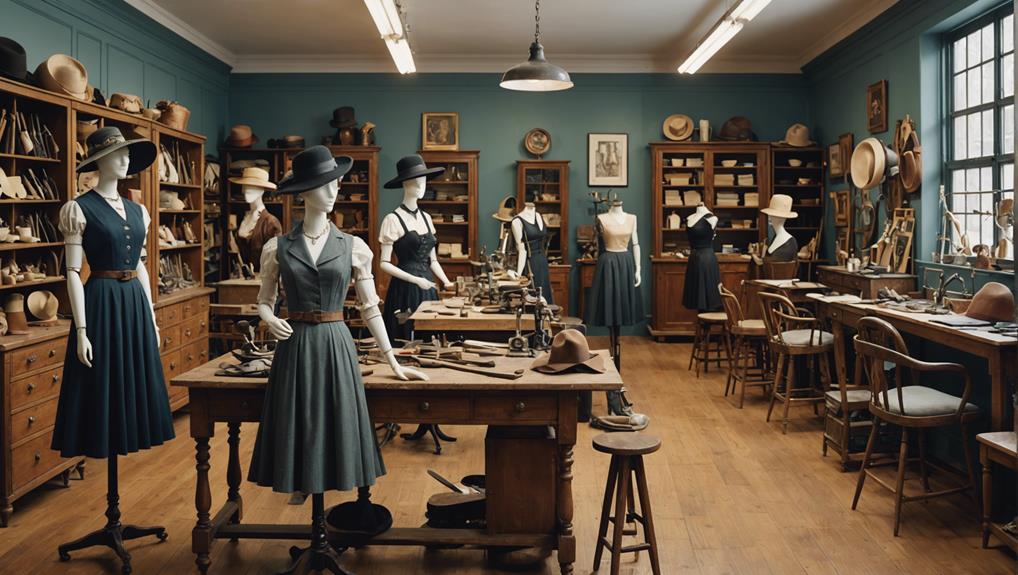Discover how Luton’s community adapts to road closures and infrastructure upgrades, turning short-term disruption into long-term sustainability and resilience. Learn more now!
As you explore Luton's hat industry evolution, you'll uncover a fascinating narrative of innovation, craftsmanship, and resilience. From its 18th-century emergence as a hub for quality headwear to its current focus on high-end, bespoke hats, Luton's hat industry has navigated growth, decline, and resurgence. You'll discover how the industry adapted to changing fashion trends, global competition, and wartime demands, and how it responded with modernization efforts, specialization, and a renewed emphasis on traditional craftsmanship. With its legacy shaping Luton's identity and cultural heritage, there's more to uncover about this remarkable story.
Early Beginnings of Luton's Hat Trade
When you explore the history of Luton's hat trade, you'll discover that it all began in the 18th century, when the town emerged as a major center for hat production in southern England.
During this time, Luton's hat industry was initially focused on creating exquisite straw hats for women, which quickly gained popularity. As the industry grew, it expanded to include felt hat production for men, catering to a broader market.
The high demand for Luton hats in the 18th century solidified the town's reputation as a hub for quality and fashionable headwear. You'll find that Luton's hat trade was built on a foundation of innovation, quality, and style, which would eventually propel it to become a global leader in the industry.
As you explore further into Luton's hat trade history, you'll uncover a rich narrative of entrepreneurship, craftsmanship, and dedication to excellence.
Growth of Straw Hat Production
As you explore the growth of straw hat production in Luton, you'll find that the town's innovative spirit and dedication to quality propelled the industry forward, transforming it into a global phenomenon.
By the 18th century, Luton had established itself as a hub for exquisite straw hat craftsmanship, with intricate designs and exceptional quality setting it apart from others.
The industrialization of the hat industry in Luton led to mass production, with factories churning out millions of straw hats annually by the 1930s. These hats were highly sought after, not only in Britain but also globally, symbolizing social status and exceptional craftsmanship.
The high demand for Luton's straw hats contributed significantly to the town's economic prosperity and growth. The industry's innovative machinery and techniques revolutionized production processes, setting high standards for quality and design.
As you investigate further, you'll discover how Luton's straw hat production became a byword for excellence, earning its place in the annals of hat-making history.
The Rise of Felt Hat Manufacturing

In the aftermath of World War I, Luton's hat industry underwent a significant transformation, with felt hat production emerging as a dominant force in the town's manufacturing landscape.
You might be surprised to learn that Luton's hat factories evolved to focus on felt hat manufacturing for men, with a shift away from straw hats for women. This strategic move paid off, as the introduction of machinery in felt hat production increased efficiency and quality in Luton's factories.
Here are three key aspects that contributed to the rise of felt hat manufacturing in Luton:
- Craftsmanship: Felt hats from Luton were renowned for their exceptional craftsmanship, earning the town a reputation for excellence in hat making.
- Global Reach: These high-quality felt hats were exported worldwide, further solidifying Luton's position as a hub for hat production.
- Legacy: The legacy of felt hat manufacturing in Luton continues to be celebrated, highlighting the town's historical importance in the industry.
As you explore Luton's hat industry evolution, you'll discover how the town's adaptability and innovative spirit paved the way for its success in felt hat manufacturing.
Impact of World War I on Production
Felt hat production in Luton received an unexpected boost during World War I, as you'll discover, with manufacturers capitalizing on the war-driven surge in demand for felt hats.
As the war raged on, Luton's hat factories adapted quickly, shifting their focus to meet the unprecedented demand for felt hats. The war's impact on materials and imports led to a pivot in production, with factories adapting to the new reality. This shift proved to be a blessing in disguise, as Luton's felt hat trade flourished, meeting the increased demand with ease.
The war created opportunities for Luton's felt hat manufacturers to thrive, and they seized them with both hands. As a result, felt hat production in Luton not only survived but thrived, solidifying the town's position as a key player in the industry.
The aftermath of World War I saw Luton's hat industry experiencing significant growth and success in felt hat manufacturing, paving the way for a prosperous future.
Interwar Period of Innovation

During the interwar period, you witnessed Luton's hat industry undergo a remarkable transformation, driven by a surge in innovation and production that propelled the town to the forefront of hat manufacturing. As you explored the town, you saw hat factories embracing modern machinery and techniques to boost efficiency. The introduction of steam-powered machines revolutionized hat-making processes, allowing for greater precision and speed.
Here are three key advancements that contributed to Luton's success:
- Mechanization: Steam-powered machines enabled mass production, increasing the quantity and quality of hats.
- Technological innovations: New techniques and materials improved the durability and style of hats, making them more appealing to consumers.
- Investment in infrastructure: Upgraded factories and equipment enabled hat-makers to experiment with new designs and materials, further solidifying Luton's reputation as a hub for hat production.
As a result, Luton's hat industry thrived, producing high-quality hats that gained popularity across the country. The town's commitment to innovation and progress cemented its position as a leading center for hat manufacturing, paving the way for future growth and success.
Post-War Hat Industry Boom
You enter a new era of unprecedented growth as Luton's hat industry, fresh from its interwar innovations, surges forward in the aftermath of World War I. The demand for hats increases, and Luton's factories respond by ramping up production, focusing on high-quality felt hats for men.
The town's hat-making prowess earns it a reputation as a hub for excellence, with millions of hats produced annually. Exports soar, and Luton's hats gain recognition globally. As you walk through the bustling factories, you're surrounded by the hum of machinery, the chatter of skilled craftsmen, and the sweet aroma of felt. The air is alive with the energy of a thriving industry.
In the 1920s and 1930s, Luton produces millions of felt hats, solidifying its position as a leading hat-making town. This period marks a golden era for Luton's hat industry, one of unparalleled prosperity and growth. You're witnessing a true boom, as Luton's hat makers push the boundaries of craftsmanship and innovation, cementing the town's reputation as a beacon of excellence in the world of hats.
Decline and Resurgence in 1960s

As Luton's hat industry approached the 1960s, a perfect storm of changing fashion trends and increased competition from foreign manufacturers marked the beginning of a decline that would see many factories shutter their doors. You might've expected the industry to disappear entirely, but instead, a small resurgence emerged. This resurgence was fueled by modernization efforts and the introduction of new technologies, allowing some manufacturers to adapt and thrive.
Some entrepreneurs capitalized on the changing market by producing more fashionable and niche hats. This shift towards specialization helped them stay afloat despite the decline. Additionally, the 1960s saw a renewed interest in traditional hat-making techniques and craftsmanship.
Here are three key factors that contributed to the resurgence:
- Modernization efforts: The adoption of new technologies and manufacturing techniques helped reduce production costs and increase efficiency.
- Specialization: Manufacturers focused on producing niche or high-end hats, catering to a changing market.
- Renewed interest in traditional craftsmanship: The industry saw a renewed appreciation for traditional hat-making techniques, leading to a small resurgence in the industry.
Despite the challenges, Luton's hat industry refused to disappear, and its resilience paved the way for a brighter future.
Global Competition and Challenges
Global competition in the hat industry intensified, forcing Luton's manufacturers to confront the harsh realities of a rapidly changing market. You can imagine the pressure they faced as mass production methods in other countries flooded the market with cheaper alternatives, making it tough for Luton's hat-makers to compete.
The influx of imports not only affected sales but also led to a decline in demand for traditional hats, further exacerbating the challenges faced by the local industry. To make matters worse, technological advancements in other countries enabled more efficient production processes, making Luton's manufacturers struggle to keep up.
As you explore further into this period, you'll realize that Luton's hat industry was at a crossroads, where adapting to changing market dynamics and consumer preferences was essential to staying relevant in the global hat industry. It was a make-or-break situation, where only the most innovative and resilient manufacturers could survive.
Shift to Fashion and Craftsmanship

In response to the challenges posed by global competition, Luton's hat industry underwent a significant metamorphosis, shifting its focus from mass production to high-quality, bespoke hats that showcased exceptional craftsmanship and attention to detail. You can see the impact of this change in the intricate designs, unique styles, and attention to detail that now define Luton's hats. As a result, craftsmanship became a key selling point, emphasizing the skills and techniques of Luton's hat makers.
Here are three key aspects of this evolution:
- Emphasis on traditional techniques: Luton's hat makers revived traditional skills and methods to create hats that were both fashionable and sought-after.
- Influence of fashion trends: Hat designs were heavily influenced by the latest fashion trends, leading to a shift towards more creative and individualized pieces.
- Focus on bespoke hats: The industry evolved to producing high-quality, handmade hats that catered to individual tastes and preferences.
This shift towards fashion and craftsmanship not only helped Luton's hat industry stay competitive but also established it as a hub for bespoke hat-making.
Legacy of Luton's Hat Industry Heritage
Today, Luton's hat-making legacy continues to shape the town's identity, with its rich history influencing modern industries and cultural heritage.
As you explore Luton, you'll discover that the town's history is deeply intertwined with the legacy of its hat industry. Despite the industry's decline in the late 20th century, Luton remains synonymous with hat-making, and preservation efforts are ongoing to conserve this heritage.
You'll find that modern industries in Luton continue to be influenced by the traditions and innovations of hat-making, from craftsmanship to fashion. The cultural identity of Luton remains connected to its rich history in the hat industry, and you can sense the pride and nostalgia that permeates the town.
As you investigate further into Luton's history, you'll uncover the fascinating story of how the hat industry shaped the town's development and continues to inspire new generations. By embracing its hat-making heritage, Luton is able to celebrate its unique identity and look towards a bright future.
Frequently Asked Questions
Why Is Luton Famous for Hats?
You wonder why Luton's famous for hats? It's because of its rich history in hat-making, dating back to the 18th century, producing millions of hats annually, and its diverse straw and felt hat styles!
Are Hats Still Made in Luton?
You'll be pleased to know that, yes, hats are still made in Luton, although on a much smaller scale than in its heyday. Some traditional manufacturers continue to craft hats using time-honored methods.
Conclusion
As you reflect on Luton's hat industry evolution, you've witnessed a remarkable journey - from humble beginnings to innovative growth, wartime disruptions, and eventual decline.
Yet, amidst global competition, Luton's hat makers adapted, shifting focus to fashion and craftsmanship. Today, the town's rich heritage remains, a tribute to the ingenuity and perseverance of its people.
The legacy of Luton's hat industry serves as a beacon, inspiring future generations to cherish and build upon this remarkable history.
